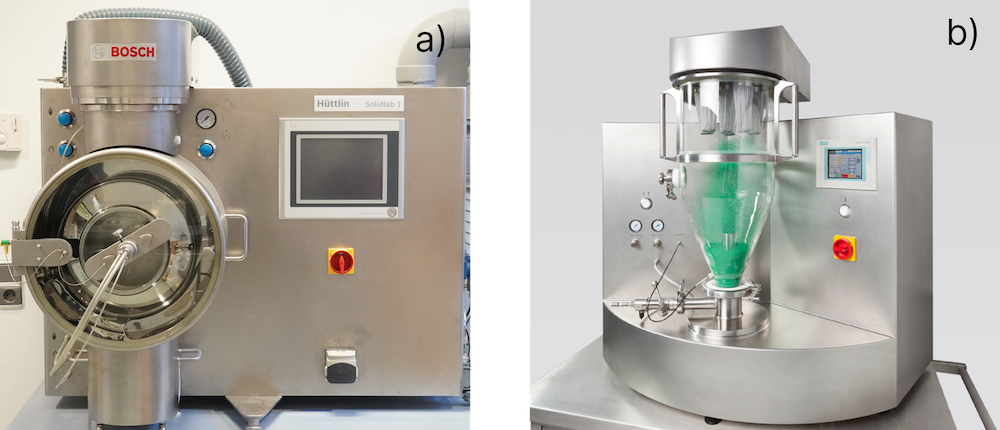Coating is a process where a layer is applied to a substrate in order to achieve different benefits. Besides being used purely for cosmetic purposes to add color in order to differentiate white substrates from each other, coatings can also be designed as functional systems. Pharmaceutical coatings can be applied on multiple oral solid dosage forms (OSD), such as tablets and pellets, granules or capsules.

Enteric coating is a type of functional coating. It can be used to allow a release of the active pharmaceutical ingredient (API) after the stomach in the small intestine or in a lower part of the digestive tract. Another application is to use it as a protective layer of the OSD against the acidity of the stomach. Thus, avoiding the release of the drug in the stomach. This protection can be needed for different reasons, such as:

Once the medicine passes the pyloric valve, it reaches the first small intestine called the duodenum having a pH around 5. Depending on the pH solubility of the enteric coating, the API can already be released in this region of the digestive tract and be absorbed into the blood stream.
During the enteric coating process a uniform polymer film layer should be applied to the surface in order to obtain the desired gastric resistance. This film should be insoluble in gastric media, but soluble in the intestine. According to the Pharmacopoeias, two hours of gastric resistance is required for an efficient enteric coating layer.
Different equipment can be used depending on the OSD form. Usually when tablets and capsules are coated, a pan coater (Figure 1a) is used and in the case of pellets or granules a fluid bed (Figure 1b) is used. The figures 1a and 1b are showing typical equipment used in a laboratory scale during the development phase. The amount of polymer to be applied to achieve an optimal gastric resistance is defined by the polymer weight gain linked to the surface area of the substrate.
Due to the higher surface area of pellets/granules compared to tablets/capsules, higher weight gain is needed for these oral solid dosage forms. Tablets and capsules are coated to around 8% weight gain and pellets/granules to a weight gain of 15-30%, as a reference.

Figure 1. Example of equipment used for oral solid dosage forms coating; a) pan coater Bosch Solidlab 1 and b) fluid bed Diosna Minilab XP.
An enteric coating formulation is based on a functional polymer (responsible for the enteric properties of the coating), a plasticizer, an anti-tacking agent, pigments and the solvent (can be water or organic solvents).
Several polymers can be used for enteric coating, coming from animal origin: shellac for example (ester of aleuritic acid), synthetic origin: poly(methacrylic acid-co-methyl methacrylate), polyvinyl acetate phthalate (PVAP), or based on cellulose: cellulose acetate phthalate (CAP), hydroxypropyl methylcellulose phthalate (HPMCP) and hydroxypropyl methylcellulose acetate succinate (HPMCAS). The enteric coating polymers are insoluble at low pH, and they start to dissolve when the pH increases in the gastrointestinal tract. The available polymers on the market have a release between pH 4.5 to 7.

Shin-Etsu is supplying HPMCP and HPMCAS which are two enteric polymers based on hypromellose as a backbone structure that is a non-toxic material and has been used in the pharmaceutical industry for many years. HPMCP can be considered a part of a second generation of enteric polymers. It is soluble in organic solvents (typically ethanol/water or isopropanol/ water systems) and is less hygroscopic than CAP, leading to a better stability of the coating layer. HPMCAS can be considered as part of the third generation. It can be either applied in solvent systems or dispersed in water.
The use of water-based coatings became more popular in the past decades due to the environmental concerns of using organic solvents and the linked residual amounts leading to pollution, high toxicity and high risk for the operators. Water is non-toxic and an environmentally friendly solvent. For that reason, water-based coatings are safer, and they are also cheaper compared to organic-based coatings. Besides those advantages, some other considerations have to be taken into account when selecting the media used in enteric coating. Aqueous coatings can also have some disadvantages. Some examples are that the water can affect the tablet core especially in cases of hygroscopic actives, the drying step will be longer when water is used compared to organic solvent systems and water dispersions have an increased risk of microbial contamination.
1. Salawi A., Pharmaceutical Coating and Its Different Approaches, a Review. Polymers 2022, 14, 3318. - https://www.mdpi.com/2073-4360/14/16/3318
2. Fu M., Blechar J.A., Sauer A., Al-Gousous J., Langguth P., In Vitro Evaluation of Enteric-Coated HPMC Capsules-Effect of Formulation Factors on Product Performance. Pharmaceutics 2020 23;12(8):696. - https://pubmed.ncbi.nlm.nih.gov/32717908/
3. Seo K.-S., Bajracharya R., Lee S.H., Han H.-K., Pharmaceutical Application of Tablet Film Coating. Pharmaceutics 2020, 12, 853. - https://www.mdpi.com/1999-4923/12/9/853
4. Maderuelo C., Lanao J.M. and Zarzuelo A., Enteric coating of oral solid dosage forms as a tool to improve drug bioavailability, European Journal of Pharmaceutical Sciences 2019, 138, 105019. - https://www.sciencedirect.com/science/article/abs/pii/S0928098719302830
5. Missaghi S., Young C., Fegely K., Rajabi-Siahboomi A.R., Delayed release film coating applications on oral solid dosage forms of proton pump inhibitors: case studies. Drug Dev Ind Pharm. 2010 Feb;36(2):180-9. - https://pubmed.ncbi.nlm.nih.gov/20070183/
6. Obara S., Kokubo H. Application of HPMC and HPMCAS to Aqueous Film Coating of Pharmaceutical Dosage Forms. In: McGinity J.W., Felton L.A., editors. Aqueous Polymeric coatings for Pharmaceutical Dosage Forms. Informa Healthcare USA, Inc.; New York, NY, USA: 2008. pp. 304–305.

Solid pharmaceutical dosage forms, such as tablets and capsules, are the most used drug delivery systems, favored for their ease of production and patient preference.
Read more
Oral solid dosage forms (OSD) present numerous options, over semi-solids and liquids, to enhance patient acceptance to medicines.
Read more
In June 2022, Persistence Market Research presented a market outlook of orally disintegrating tablet (ODT) for the next years (2022 - 2025). According to this research “The ODT Market is likely to have compound annual growth rate (CAGR) of 8.5% over the forecast period.
Read more